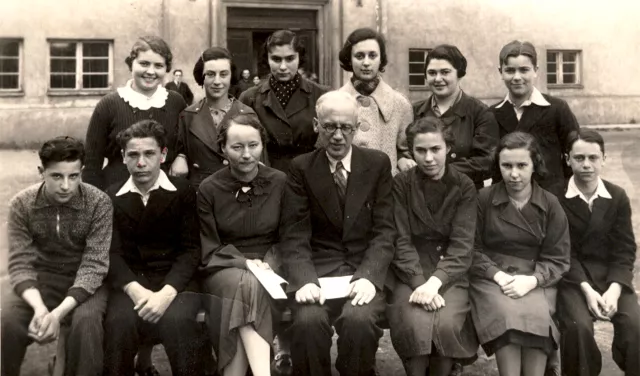Liya Kaplan with her schoolmates
This picture is of the 8th grade at Tallinn high school. I?m second to the right in the back row. From left to right, front row: Gabriel Piskarevich, currently residing in Israel; Binya Gordon, living in Tallinn; Estonian language teacher Valdur; headmaster of our school Samuel Gourin; Aranovich, died after WWII; Ester Lerenman, recently died in Israel; Khone Aranovich, died after WWII in Tallinn. Back row: Sarah Rybka, died in Tallinn after WWII; Luba Turetskiy (married name Rosenberg), currently living in Tallinn; Khana Aronovich, died in 1941 during Holocaust; daughter of the headmaster Evgenia Gourina (married name: Loeov), lived in Tallinn, died in the 2000s; I and Itshak Grouzin, currently living in Tallinn. The picture was taken in Tallinn in 1937.
At the age of seven I entered the Ivrit school, where my elder siblings went. Apart from Ivrit, we studied German, French and English. The school was secular, but we studied religion, history and Jewish tradition.
We were members of youth Zionist organizations at school. I was a member of Hashomer Hatzair, my friend joined Betar. There was no animosity among us.
When in 1933 Hitler came to power in Germany, the spirit of hatred towards Jews started penetrating Estonia. All of us felt the anti-Semitism. At that time we didn't understand the scale of it. There were short articles in the press, without details and comments. We learned about those events from the radio and papers, but no details were provided. We had wirelesses and could listen to any radio station of the world. Thus, we found out about the atrocities the fascists in Germany were committing and about the concentration camps. Then fugitives from Germany showed up. There weren?t very many of them. It must have been hard to escape.
We should all have understood that no good should be expected from Germans, but unfortunately, most Jews didn't take it seriously. At that time, Estonian fascist organizations were founded. It was during this period that for the first time in my life I heard someone say, ?Bloody Jews.? Nobody had ever said anything like that before. We didn't bother anybody in Estonia. In about 1938 discrimination of Jews started; it was not that conspicuous, but it was still there.





















